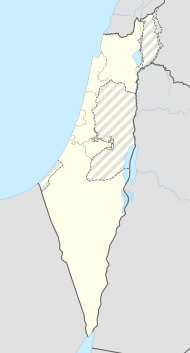Kabul (Israel)
| Kabul | ||
|---|---|---|

|
||
| Kabul (2011) | ||
| Basic data | ||
| hebrew : | כָּאבּוּל | |
| arabic : | كابول | |
| State : |
|
|
| District : | North | |
| Coordinates : | 32 ° 52 ' N , 35 ° 12' E | |
| Height : | 74 m | |
| Area : | 7.149 km² | |
| Residents : | 13,854 (as of 2018) | |
| Population density : | 1,938 inhabitants per km² | |
| Community code : | 0504 | |
| Time zone : | UTC + 2 | |
|
|
||
Kabul ( Arabic كابول, DMG Kābūl ; Hebrew כָּאבּוּל Kabul , the Tanakh כָּב֖וּל Kavūl ) is a purely Arab-inhabited small town and a biblical area southeast of the city of Akko in the northern district of Israel . The city lies at an altitude of 40 to 160 meters above sea level. The etymology of the name is unclear, the name is derived from both the word gvul (“border”) and a term for “fertile earth” and the Hebrew word mekubbal . According to tradition, the people of Kabul were so rich that they dressed in gold and silver.
General
Since the end of the mandate, Kabul has developed from a small town with around 100 buildings, no educational institutions and less than 600 inhabitants to a city with 13,854 inhabitants (2018) and several schools, health facilities and an agricultural research center on an area of almost 7.15 km². The only access road to Kabul is from Road 70 from the west.
history
The place is probably already mentioned in the Bible as a border place of the area of Asser during the conquest under Joshua ( Jos 19,27 EU ). Later Kabul was handed over by King Solomon to Hiram of Tire as thanks for the help with the temple construction . Flavius Josephus describes Kabul ( Chabolo ) as a former border town of the Ptolemaic region , from which raids into Galilee were made. This old Kabul went under because of internal disputes. There is no historical evidence that Kabul today is identical to the biblical one and that mentioned by Flavius Josephus.
In 985, Al-Muqaddasī described Kabul, which was then under Abbasid rule, as a place with vast sugar cane plantations and the place of origin of the best sugar in the whole of Syria. During the time of the Arab caliphates, Kabul was one of the main locations of a Syrian military district.
In the Middle Ages, Kabul became a Jewish pilgrimage city because, according to tradition, the tombs of Ruben and Simeon are in Kabul, as well as those of the prophet Micah . During the Middle Ages, other tombs were added, including those of Jehuda ha-Levi , Abraham ibn Esra and Solomon ibn Gabirol .
Later on, Kabul was transformed into a purely Arabic place. In the war for Israel's independence in 1948, Kabul was taken without a fight by the Sheva Brigade during Operation Dekel . Only a few residents of Kabul fled, and most of the residents were neutral or friendly towards the Israeli armed forces. Therefore, Kabul remained as an Arab place and was raised to the status of a local association in 1974 . Nevertheless, Kabul is described by the Palestinian side as "ethnically cleansed".
literature
- Immanuel Benzinger : Chabolo . In: Paulys Realencyclopadie der classischen Antiquity Science (RE). Volume III, 2, Stuttgart 1899, Col. 2017.
- Edward Robinson, Eli Smith: Biblical researches in Palestine and the adjacent regions: a journal of travels in the years 1838 & 1852 ; J. Murray, London 1856
- Zev Vilnay: Legends of Palestine ; The Jewish Publication Society of America, 1932
Individual evidence
- ↑ אוכלוסייה ביישובים 2018 (population of the settlements 2018). (XLSX; 0.13 MB) Israel Central Bureau of Statistics , August 25, 2019, accessed May 11, 2020 .
- ↑ a b Vilnay: Legends of Palestine , p. 406f
- ↑ אוכלוסייה ביישובים 2018 (population of the settlements 2018). (XLSX; 0.13 MB) Israel Central Bureau of Statistics , August 25, 2019, accessed May 11, 2020 .
- ^ Robinson, Smith: Biblical researches in Palestine and the adjacent regions , p. 88
- ↑ Several Palestinian families live in Kabul after they were expelled from their villages in 1948. Kabul at Palestineremembered.com
